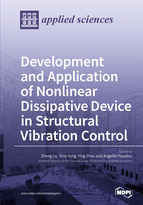Development and Application of Nonlinear Dissipative Device in Structural Vibration Control
A special issue of Applied Sciences (ISSN 2076-3417). This special issue belongs to the section "Mechanical Engineering".
Deadline for manuscript submissions: closed (31 December 2017) | Viewed by 78352
Special Issue Editors
Interests: structural control; seismic design of building structures; renewable energy
Special Issues, Collections and Topics in MDPI journals
Interests: seismic behaviour and design of steel; concrete and composite structures; seismic behaviour and design of tall buildings; development of performance-based evaluation methodology and code design procedures for new and existing structures; energy dissipation systems
Special Issues, Collections and Topics in MDPI journals
Interests: seismic performance of complex tall buildings; performance-based seismic design; structural performance of composite structures and hybrid structures; methodology and technology for structural dynamic test
Special Issues, Collections and Topics in MDPI journals
Interests: structural vibration control; particle damping technology; passive control
Special Issues, Collections and Topics in MDPI journals
Special Issue Information
Dear Colleagues,
Structural vibration control plays a very important role in civil engineering. During the past few decades, energy dissipative technologies by attaching dissipative devices or designing dissipative elements, are constantly emerging in the control of vibration. A wide range of dampers, such as friction dampers, particle dampers, viscoelastic dampers and mild steel dampers, etc., have been widely applied in buildings, bridges and towers. Under extreme loads, these dissipative devices behave nonlinear prior to the structural elements, and significantly absorb and dissipate the input energy through friction, collision and elastic-plastic hysteric deformation (bending, shear and torsion), which consequently ensure the safety and integral stability.
Interdisciplinary is the new frontier of engineering. New progresses in other fields, such as material science, mechanical engineering, etc., are encouraged to introduce into the area of civil engineering. This Special Issue focuses on the development and application of innovative nonlinear dissipative systems that mitigate the potentially catastrophic effects of extreme loading by incorporating new materials or effective mechanical control technologies. This Special Issue is promising to present contributions in exploring the energy dissipation principles and revealing the damping mechanism of the new nonlinear attenuating technology, which is conducive to extending the fundamental application of new nonlinear dampers and providing new solutions for the structural vibration control. Desired topics include, but are not limited to, the development of efficient and convenient composite nonlinear dampers, experimental investigation, advanced modeling and systematical theoretical analysis of nonlinear dynamic systems, optimization of creative nonlinear dampers and damping mechanism.
Assoc. Prof. Dr. Zheng Lu
Assoc. Prof. Dr. Tony Yang
Prof. Dr. Ying Zhou
Assoc. Prof. Dr. Angeliki Papalou
Guest Editors
Manuscript Submission Information
Manuscripts should be submitted online at www.mdpi.com by registering and logging in to this website. Once you are registered, click here to go to the submission form. Manuscripts can be submitted until the deadline. All submissions that pass pre-check are peer-reviewed. Accepted papers will be published continuously in the journal (as soon as accepted) and will be listed together on the special issue website. Research articles, review articles as well as short communications are invited. For planned papers, a title and short abstract (about 100 words) can be sent to the Editorial Office for announcement on this website.
Submitted manuscripts should not have been published previously, nor be under consideration for publication elsewhere (except conference proceedings papers). All manuscripts are thoroughly refereed through a single-blind peer-review process. A guide for authors and other relevant information for submission of manuscripts is available on the Instructions for Authors page. Applied Sciences is an international peer-reviewed open access semimonthly journal published by MDPI.
Please visit the Instructions for Authors page before submitting a manuscript. The Article Processing Charge (APC) for publication in this open access journal is 2400 CHF (Swiss Francs). Submitted papers should be well formatted and use good English. Authors may use MDPI's English editing service prior to publication or during author revisions.
Keywords
- Nonlinear dissipative device
- Innovative nonlinear damper
- Energy dissipation
- Structural vibration control
- Damping mechanism
- Particle damper
- Tuned mass damper
- New material
- Nonlinear and high-damping material
- Optimal design
- Practical application







